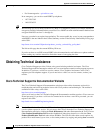
42
Avaya Definity Gx/PBXLink Integration Guide for Cisco Unity 4.0
OL-3105-15
Appendix: Using Alternate Extensions and MWIs
Alternate Extensions
• Offer easy message access on direct calls from a cell phone, home phone, or phone at an alternate
work site (assuming that the phone number is passed along to Cisco Unity from these other phone
systems). In addition, when such phones are used as alternate extensions, and are set to forward to
Cisco Unity, callers can listen to the subscriber greeting, and leave messages for the subscriber just
as they would when dialing the primary extension for the subscriber.
Tip To reduce the number of requests from subscribers who want alternate extensions set up for
multiple cell phones, home phones, and other phones, give subscribers class of service (COS)
rights to specify their own set of alternate extensions. (See the Subscribers > Class of Service >
Profile page.) With proper COS rights, a subscriber can specify up to five alternate extensions
in the Cisco Unity Assistant—in addition to the nine that you can specify on the Subscribers >
Alternate Extensions page in the Cisco Unity Administrator.
• Enable URL-based extensions in Cisco Unity for an integration with a SIP phone system.
How Alternate Extensions Work
Before you set up alternate extensions, review the following list for information on how alternate
extensions work:
• Alternate extensions cannot exceed 30 characters in length. By default, each administrator-defined
alternate extension must be at least 3 characters in length, while subscriber-defined alternate
extensions must be at least 10 characters.
You can use the Advanced Settings tool in Tools Depot to specify a minimum extension length for
the extensions entered in the Cisco Unity Administrator and the Cisco Unity Assistant. Refer to the
Advanced Settings Tool Help for details on using the settings. Respectively, the settings are
Administration—Set the Minimum Length for Locations, and Administration—Set the Minimum
Length for Subscriber-Defined Alternate Extensions.
• You can control whether subscribers can use the Cisco Unity Assistant to view the alternate
extensions that you specify in the Cisco Unity Administrator. To do so, see the Subscribers > Class
of Service > Profile page. The Subscriber-Defined Alternate Extension table displays the alternate
extensions that the subscriber adds.
• Neither the Cisco Unity Administrator nor the Cisco Unity Assistant will accept an extension that
is already assigned to another subscriber (either as a primary or alternate extension), or to a public
distribution list, call handler, directory handler, or interview handler. Cisco Unity verifies that each
alternate extension is unique—up to the dialing domain level, if applicable—before allowing either
an administrator or a subscriber to create it.
• All alternate extensions use the same transfer settings as the primary extension.
• In many cases, Cisco Unity can activate a message waiting indicator (MWI) for an alternate
extension. However, depending on the phones and phone systems involved, some additional phone
system programming may be required to set this up.
Setting Up Alternate Extensions
Do the applicable procedure to add, modify, or delete alternate extensions:
• To Add Administrator-Defined Alternate Extensions, page 43
• To Modify or Delete Alternate Extension(s), page 43


















